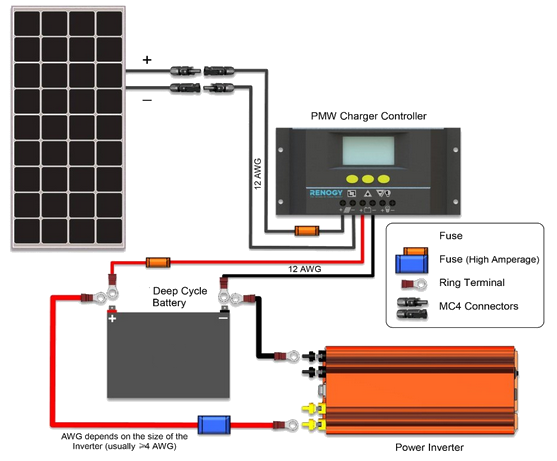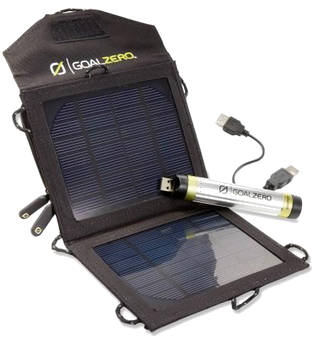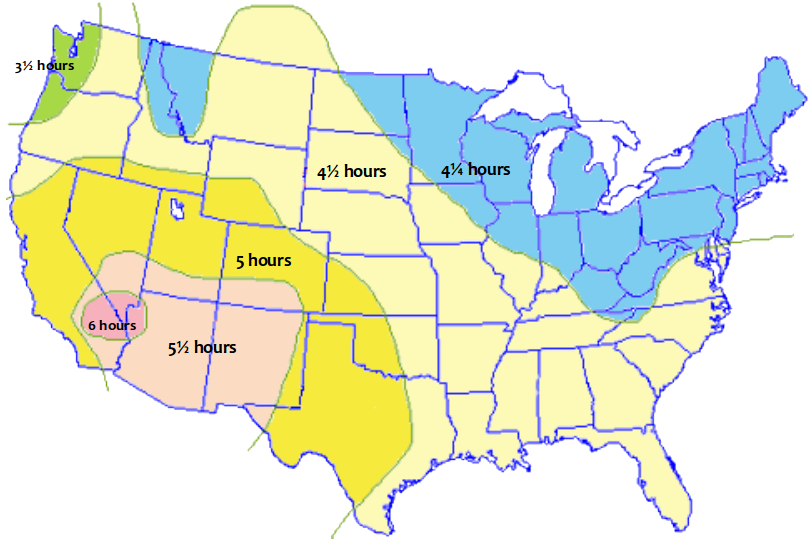
Solar power is a rather advanced subject for which it's understandable that someone would rely on packaged systems rather than seek enough technical understanding in order to piece something together. Nevertheless, ...
Solar power is the conversion of sunlight into electricity typically using a photovoltaic device commonly called a solar panel. A solar panel consists of an array of many photovoltaic cells made up of semi-conductors like crystalline silicon or cadmium telluride.
Note: Because photovoltaics are a little like diodes, transistors or integrated circuits, they may be damaged by electro-magnetic pulse (EMP).
When sunlight falls upon these cells, it "excites" the electrons present in them which, in movement, create electricity. The history of this means of generating electricity goes back to 1839 when A. E. Becquerel (yup, a French guy) observed the photovoltaic effect. The first solar cell in 1883 was less than 1% efficient (meaning less than 1% of the sunlight's apparent power is converted into electrical current). Efficiencies increased over the next century, by 1954 (6%), 1959 (10%), 1985 (20%), 1994 (30%) and work in academia achieved over 40% in the next two decades.
Much of the work in solar energy has been to make it commercially viable by lowering the cost rather than improving efficiency. In 1955, commercial solar cell technology cost around $1,785/Watt ($20,000 in 2014 dollars). Today, it's possible to construct a system for around $1 or $2 per Watt. In commercial solar energy plants, the costs are even lower, around 15 cents per kiloWatt.
For home use, there are three types of installations, on-grid, off-grid and islandable.
The first depends on where you live and what company you purchase power from. An installation is typically very expensive, but much of the cost is rebated to the home owner and any electricity produced in excess of what is needed by the homeowner is sold to the company which accelerates payback.
Note: On-grid systems no longer function when the power goes out. This is because a) you pay specialized electricians to connect you to the power company's grid in such a way as to benefit the company and you, and b) the components of connection employed are not chosen and assembled in such a way as to make off-grid use possible. The solar panels and some other components could be made to work, but with considerable expense and understanding. Plus, the power company wants the installation done correctly and not compromised by inexpert fiddling. Also, in situations where electrical utility workers are working in the neighborhood to restore power, their lives might be endangered as they restore power when some homeowner's solar electrical system is feeding power back to the grid in some unexpected way.
The third sort of system, islandable, purports to be on the grid when being on the grid is possible and desirable, and off the grid when not.
In this document, we're only concerned with off-grid because the issues are simpler.
There are infinite ways to put together a system that's off the grid. And you're on your own for financing it. The first thing to consider is what you need electrical power for. Based on that answer, you then choose the magnitude of the system you wish to build. For example, where along this continuum would you think to stop knowing that the further you go, the more exponentially priced your system would be?
For each of these levels you must either know, understand and calculate the electrical requirements, or you must purchase a system package that claims it can achieve the goal you've set for yourself.
We will list references for some packages as examples only for you to investigate. Disclaimer: we do not claim to own or have experience with any of these systems necessarily. However, we do claim not to be making money or any other benefit from your purchase of any of them.
A basic solar energy system consists of the components shown here. These are, from left to right, ...

Likely, you don't recognize two of these compoents.
First, the charge controller. This component regulates the electricity coming off the solar panels making it a certain, constant voltage and ensuring that the battery or batteries you're charging will not be damaged. Basically, it ensures that the solar panels won't over-charge and damage your batteries during the daytime and that the solar panel won't discharge your batteries at night when it's not producing power.
Second, the inverter. You probably own an inverter. It's the box you plug into your car's or recreational vehicle's 12-volt electrical system to give you 110 volts. This component changes the electricity coming from the battery(ies) to something you can use, probably one of
Strictly speaking, though, an inverter changes direct current (DC, like what comes out of batteries of any size) to alternating current (AC), the electrical current that flows in your house and runs the appliances there.
Specialized, smaller solar packages often have electrical outputs specifically designed to power or charge cellphones, reading devices or small computers (often mini USB ports). The power for these isn't inverted, it remains DC, but it's carefully conditioned in order not to damage them.
Let's look more practically at a commercial system. This schematic, from a small, commercially available system, shows how the components are actually hooked up. It's pretty simple wiring—less confusing than a home sprinkler system.

This inexpensive system, $80 at this writing, claims to handle a few devices such as cell phones, music players, tablets, reading devices, etc. Its output is a USB connector. You open, unfold and lay the unit on your car rooftop. It's called the GoalZero 8. GoalZero makes a whole line of models from this one up to ones that include lights and radios, battery packs, inverters and other equipment to be powered.

You may have home medical equipment such as a CPAP machine you need to run. It has to run all night long, perferably several nights to cover for the cloudy or stormy days when there is no sunshine. Such a system would need some good batteries and one or more large panels plus a controller and inverter since the CPAP would probably run on 110 volts—supplied by the inverter.
This is a 12-volt system, so you have to purchase 12-volt components. If you're putting something like this together from different suppliers, such as buying the components separately on Amazon, you'll need to be careful to understand how this works. For example, did you catch how there are two batteries here? They're 6-volt golf cart batteries and you have to wire them together to make 12 volts. Etc. Simple, but if you're not into electrical theory, you should get help.
Why 6-volt golf cart instead of car batteries? Because these batteries are designed to be clustered together (car batteries are not) and they last much longer than car batteries. They are about the same size as car batteries. See Batteries for Solar Power.
Learning stuff like this is why we're taking the trouble to do the research and write it up here—so you don't have to if you don't want to.
Here are the components (click an image to see it bigger):
In addition to this, you'll need cabling as shown in the second diagram above...
Something to note: all this cabling suddenly becomes a problem. You're dealing with a system in hard circumstances. The longer wires or cables are, the more efficiency your system will lose to them. And, the more length, the bigger the system you'll need to plan. Increasing the gauge of the cables helps a lot, but this increases the cost of the cables and does not completely eliminate the loss.
The best experts on-line appear to answer questions like, "how many panels?", "how many batteries?" or "what size controller?" by turning the questions around:
Then, they give answers with logic such as this example for a device, like a standard notebook computer plugged in 10 hours per day.
| 60 Watts | per hour used by device (computer) connected to inverter |
| 10 hours | per day consuming power |
| 600 Watts | per day (60 Watt-hours) |
| Batteries have an Ampere-hour rating. Convert wattage to amperage. To accomplish this, divide watts needed by voltage of the battery planned. Assume for this example it's a common 12-volt system: | |
| 600 Watt-hours ÷ 12 volts = 50 Ampere-hours | |
| Use deep-cycle batteries and do not draw them below 50% of their total capacity (or their life will be dramatically shortened). For this, multiply the 50 Ampere-hour figure by 2 to avoid draining more than 50% each day. This means at the start at least a 100 Ampere-hour battery: | |
| 50 Ampere-hours × 2 = 100 Ampere-hours | |
| Next, remember that any inverter will not be 100% efficient. It will waste power (Watts) to invert DC current into AC for your device. Therefore, over-size the batteries again to account for that: | |
| 125 Ampere-hour battery (ies) | |
| Now, to determine how many panels will be needed to keep the batteries charged so these can handle the inverter drawing 60 Watts per hour for 10 hours per day, ask how much capacity would be required to charge the batteries fully. To answer this, consult the solar insolation map for your location. (See below.) For this example, assume 4½ hours of bright sunlight per day (the pale yellow region in the map). Let's also assume that the main components of our system are common, 100-Watt panels. | |
| 4½ hours × 100-Watt panel = 450 Watts per day charging the batteries | |
| Therefore, to ensure 600 Watts per day, something less than two panels must be employed to ensure the batteries come back to full every day. Since we can't buy and install fractional panels, we round up. | |
| 2 × 100-Watt panels yielding 900 Watts (in the pale, yellow zone) | |
| 900 Watts is more than the 600 Watts we calculated we'd need. However, our daylight figure has a flaw: in winter, we must subtract from the 900 Watts because the sun is lower on the horizon (not so direct) and is up for a short time. | |
| 900 Watts × 0.75 or 0.5 = 675 or 450 Watts | |
| So, we might even still be a bit low, but for this example, let's go with the two-panel/two-battery system we've just theorized. | |
Note: using common components purchased from Amazon in 2014, with about
50' of electrical cable between the panels and the controller, this
system amounts to something like the following:
$300 2 solar panels $ 30 1 charger controller $170 2 Costco 125Ah golf-cart batteries $ 30 1 12v DC inverter, 100v output $ 50 50' 10/2 with ground Romex (from Home Depot) $ 20 other incidentals like battery cables ---- $600 total system cost |
|
Obviously, if you need to run a CPAP machine with heated hose for 8 hours or a respirator or only recharge your Kindle and a portable Blu-ray player, these are all different demands that will require adjustments to increase or reduce the system you plan.
When planning your system, it's important to understand how much sun you can expect to get where you live. This map doesn't take into account your location under the shadow of a mountain in the afternoon, in a dense forest, etc.
These are average annual figures. For winter-only, you can count on 25-50% less than posted here.

Links good as of this date:
These links do not constitue product endorsements.